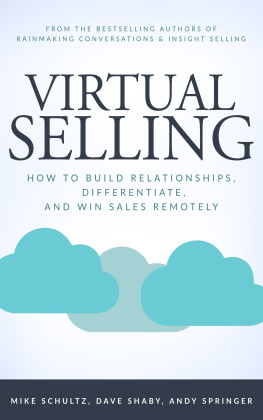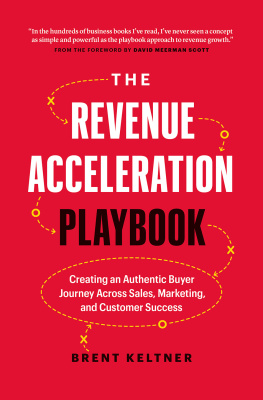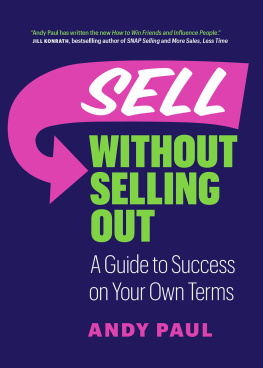
Cover image: iStock/CurvaBezier
Cover design: Wiley
Copyright 2014 by Sales Performance International, LLC. All rights reserved.
Published by John Wiley & Sons, Inc., Hoboken, New Jersey.
Published simultaneously in Canada.
No part of this publication may be reproduced, stored in a retrieval system, or transmitted in any form or by any means, electronic, mechanical, photocopying, recording, scanning, or otherwise, except as permitted under Section 107 or 108 of the 1976 United States Copyright Act, without either the prior written permission of the Publisher, or authorization through payment of the appropriate per-copy fee to the Copyright Clearance Center, 222 Rosewood Drive, Danvers, MA 01923, (978) 750-8400, fax (978) 646-8600, or on the web at www.copyright.com. Requests to the Publisher for permission should be addressed to the Permissions Department, John Wiley & Sons, Inc., 111 River Street, Hoboken, NJ 07030, (201) 748-6011, fax (201) 748-6008, or online at www.wiley.com/go/permissions.
Limit of Liability/Disclaimer of Warranty: While the publisher and author have used their best efforts in preparing this book, they make no representations or warranties with the respect to the accuracy or completeness of the contents of this book and specifically disclaim any implied warranties of merchantability or fitness for a particular purpose. No warranty may be created or extended by sales representatives or written sales materials. The advice and strategies contained herein may not be suitable for your situation. You should consult with a professional where appropriate. Neither the publisher nor the author shall be liable for damages arising herefrom.
For general information about our other products and services, please contact our Customer Care Department within the United States at (800) 762-2974, outside the United States at (317) 572-3993 or fax (317) 572-4002.
Wiley publishes in a variety of print and electronic formats and by print-on-demand. Some~material included with standard print versions of this book may not be included in e-books or in print-on-demand. If this book refers to media such as a CD or DVD that is not included in the version you purchased, you may download this material at http://booksupport.wiley.com. For more information about Wiley products, visit www.wiley.com.
ISBN 978-1-118-87242-0 (cloth); ISBN 978-1-118-87235-2 (ebk); ISBN~978-1-118-87237-6 (ebk)
Dedicated to sales and marketing professionals, who commit themselves to improve their performance and contribute to their customers' success.
To our Sales Performance International family, who commit themselves every day to helping improve our clients' business results.
To our families, friends, and mentors who support, encourage, and allow us to travel the world in pursuit of our dreams.
To teachers globally that help educate, train, mentor, and coach us. It is through their love for leaning and giving to others that we achieve.
To the men and women in the armed services around the world, who put themselves in harm's way to protect our freedoms.
Foreword
Buyer behavior has evolved and will continue to evolve through time. The more information buyers have access to, the less dependent they are on traditional sources of informationsalespeople. Thanks to the Internet and the wealth of information it provides, buyers are more informed and more comfortable evaluating options on their own. As a result, buyers are more knowledgeable and more empowered than ever before.
Anything or anyone that does not add value to their buying process is eliminated, including high-pressure or situationally unknowledgeable salespeople. Buyers are never again going to relinquish power, or control of their buying process, to aggressive sellers who do not have their best interest at heart.
Further, we live in a world of uncertainty, with more unpredictability than ever before. Global economic uncertainties and the recent global recessions have made individual buyers as well as the companies they represent realize, perhaps once and for all, that they must see results and maximize their return on investment in every purchase. This means buyers are more cautious than ever and they are acutely aware of the risks of making bad decisions. In order to spread the risk, they involve many more people and often form buying committees in their rigorous evaluations. If today's buyers aren't convinced about the results and the value of a purchase, they simply choose to do nothing at all.
Due to these trends, sales professionals must adapt. The good news is that I see a great transformation taking place globally with sales professionals as they work to adapt to the new buyers. In fact, my firm, ES Research Group, which analyzes trends in selling practices and conducts independent evaluations of sales training companies, is seeing sellers achieve great results when they adapt to the new buying trends.
To succeed today, sellers need to be worthy collaborators with these knowledgeable buyers. No longer can sellers drive and control the sale; buyers are too empowered and savvy. Sellers must align with where the buyers are in their buying process and collaborate with them in an open and transparent manner. The sellers who do this are winning business and they are transforming selling forever. I truly believe this, and our research backs this up.
We surveyed 239 buy-side and 352 sell-side negotiators at the end of 2012, and asked them identical questions about the buying-selling process. When our researchers asked how respondents expect the environment to change in the near future, a strong majority of both said that they believe that buyers and sellers must and will become more collaborative over the next three years.
Our firm has been tracking and reporting on Sales Performance International (SPI) for seven years, and we have always rated it among the leading firms in the sales training and sales performance industry. Keith Eades and Tim Sullivan are two of SPI's thought leaders, and they share a passion for raising the quality of the sales profession. SPI has been best known for its methodology, Solution Selling, which has been adopted by more than a million people all over the world. In many respects, that methodology has always been about effective collaboration with buyers. Keith and Tim have taken a close look at the recent changes in buyer behavior, evaluated the tenets of Solution Selling, and developed a modern view of what effective sellers need to do to succeed in today's world. The result is this book, The Collaborative Sale.
The Collaborative Sale introduces three new sales personae (Micro-Marketer, Visualizer, and Value Driver) that enable sellers to be more effective with today's savvy and informed buyers. The foundational competency behind the three new personae is called situational fluency. This competency allows sellers to engage buyers in multiple waysthrough conversations on social media outlets like LinkedIn, Facebook, or Twitter or in direct conversations with buyers when trying to create, enhance, or reengineer their visions.
To sell with the transparency The Collaborative Sale proposes may be challenging for some sellers and their organizations. I feel strongly that today's buyers are demanding transparency and are demanding that sellers add value to their buying process from the moment they are engaged.
The Collaborative Age of Selling is now upon us. The Collaborative Sale will help you make the transition.
Dave Stein
Founder and CEO
ES Research Group, Inc.
Preface
Next page






